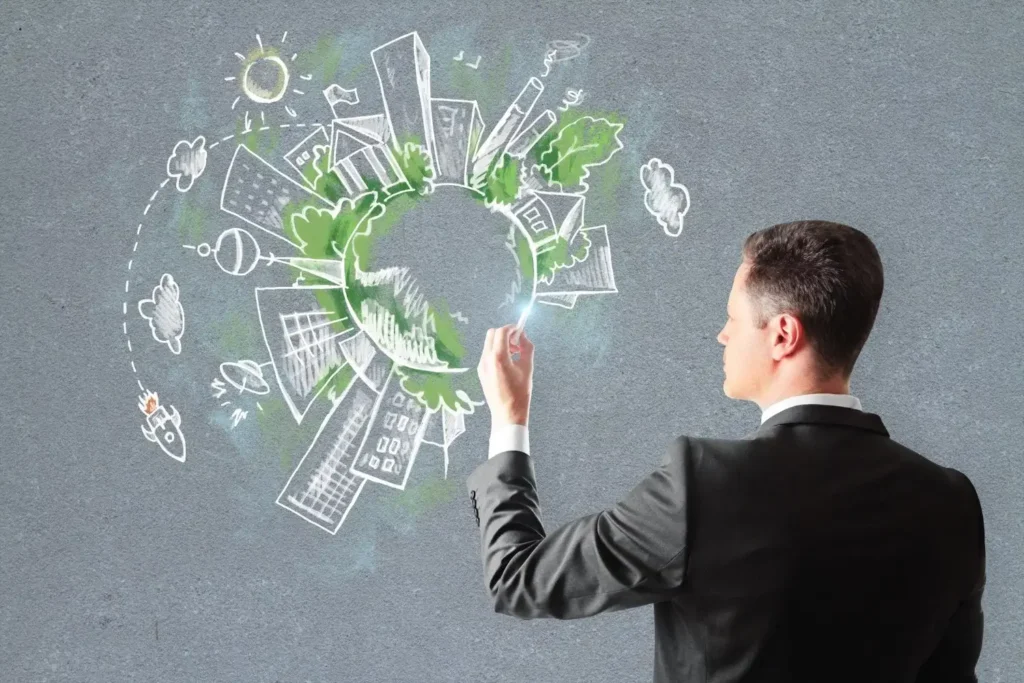Introduction
In a rapidly evolving world, sustainability has become a cornerstone of modern corporate strategies. The pressing need to tackle climate change, reduce waste, and foster social equity has placed sustainability reporting at the forefront of organizational priorities. But what exactly makes this process so essential? It’s the bridge between corporate responsibility and stakeholder trust, offering transparency about a company’s environmental, social, and governance (ESG) efforts.
Equally important is recognizing that no two industries are alike. Whether it’s a tech giant minimizing e-waste or a mining corporation restoring natural habitats, the journey to sustainability is unique for every organization. Yet, the goals remain unified—contributing to global initiatives like the United Nations Sustainable Development Goals (SDGs). This balance between distinctive industry challenges and common global ambitions forms the essence of sustainability reporting.
What is Sustainability Reporting?
Defining Sustainability Reporting
Sustainability reporting involves documenting an organization’s ESG efforts, providing a snapshot of its environmental and societal impact. These reports disclose initiatives ranging from energy consumption and greenhouse gas emissions to community engagement and ethical governance. The purpose? To build trust with stakeholders—investors, employees, customers, and policymakers—while holding the organization accountable.
At its core, sustainability reporting reflects a commitment to long-term resilience. It’s not just a public relations exercise; it’s a strategy for future-proofing businesses in an era where transparency and accountability are non-negotiable.
The Evolution of Sustainability Reporting
Sustainability reporting has evolved from a niche concept to a mainstream business practice. Initially, only a handful of environmentally conscious companies produced such reports. Today, they are a regulatory requirement in many jurisdictions and an investor mandate globally.
Key milestones in this evolution include:
- The rise of frameworks like the Global Reporting Initiative (GRI) in the 1990s.
- Increasing adoption of Sustainability Accounting Standards Board (SASB) metrics in the 2010s.
- Recent moves toward integrated reporting, combining financial and non-financial performance.
Key Frameworks and Standards
Global Reporting Initiative (GRI)
The GRI Standards are among the most widely recognized in sustainability reporting, offering guidelines for organizations across sectors. By focusing on material topics—issues most relevant to stakeholders and the environment—GRI helps companies provide comprehensive disclosures.
Sustainability Accounting Standards Board (SASB)
Where GRI emphasizes materiality from a societal perspective, SASB focuses on industry-specific financial materiality. Its sector-specific approach ensures companies address sustainability issues critical to their economic performance.
Task Force on Climate-Related Financial Disclosures (TCFD)
TCFD’s framework is a game-changer for climate-related reporting. It emphasizes four key pillars: governance, strategy, risk management, and metrics. Organizations across industries are adopting TCFD to highlight how they manage climate risks and opportunities.
Emerging Standards
The recent introduction of the International Sustainability Standards Board (ISSB) reflects growing efforts to harmonize global reporting. By integrating elements of existing frameworks, ISSB aims to simplify the reporting process while ensuring robustness.
Industry-Specific Sustainability Reporting
Energy and Mining
Industries like energy and mining face heightened scrutiny due to their significant environmental footprints. Companies in this sector must navigate challenges like reducing carbon emissions and restoring degraded landscapes. For instance, global mining firms are adopting biodiversity offset programs to balance their ecological impact.
Manufacturing and Supply Chain
The manufacturing sector often grapples with resource efficiency and emissions control. Incorporating circular economy principles, such as recycling and reusing materials, has become a critical focus. Transparent reporting ensures companies are held accountable for sustainable practices throughout their supply chains.
Technology Sector
From sourcing rare earth minerals to managing electronic waste, the tech industry faces unique sustainability challenges. Leading companies now integrate life-cycle assessments into their reporting, highlighting efforts to minimize their environmental footprint.
Agriculture and Food
Agriculture’s link to biodiversity and food security makes sustainability crucial. Reporting in this sector often includes metrics like water usage, soil health, and carbon sequestration. Innovative practices, such as regenerative farming, are gaining traction as part of sustainability commitments.
The Role of Technology in Sustainability Reporting
Big Data and Analytics
Big data plays a pivotal role in making sustainability reporting more precise. Advanced analytics platforms help organizations track metrics like carbon emissions in real time, enabling better decision-making.
AI and Machine Learning
AI-driven insights are revolutionizing how organizations approach sustainability. Predictive analytics help companies anticipate risks and optimize resource usage, making sustainability goals more attainable.
Blockchain
Blockchain technology ensures data integrity in sustainability reporting. By providing an immutable ledger of transactions, blockchain builds trust among stakeholders, particularly in industries with complex supply chains.

Challenges in Sustainability Reporting
Data Quality and Consistency
Inconsistent or incomplete data is one of the most significant hurdles in sustainability reporting. Organizations need robust systems to collect, validate, and interpret data across diverse operational units.
Regulatory Compliance
As sustainability regulations differ across regions, maintaining compliance can be daunting. Companies operating in multiple jurisdictions often face the challenge of harmonizing their reports with varying standards.
Stakeholder Engagement
Engaging diverse stakeholders—investors, communities, employees—requires balancing conflicting priorities. Effective reporting must address these concerns while staying aligned with broader corporate objectives.
Benefits of Effective Sustainability Reporting
Enhanced Corporate Reputation
Sustainability reporting significantly bolsters an organization’s reputation. Stakeholders increasingly expect companies to operate with transparency and responsibility. A well-documented sustainability report not only builds trust but also positions the company as a leader in its sector. It demonstrates a commitment to ethical practices, which can attract more customers, investors, and talent.
Companies like Unilever and Patagonia exemplify how robust sustainability reporting enhances their brand equity. These firms consistently highlight their eco-friendly practices, fostering a loyal customer base and an enviable market position.
Risk Management
Sustainability reporting plays a critical role in risk management. By identifying and addressing potential risks—such as environmental hazards or supply chain vulnerabilities—companies can mitigate disruptions and financial losses. This proactive approach ensures business continuity while aligning with environmental and social expectations.
For example, companies in the energy sector often use climate scenario analysis, part of TCFD recommendations, to understand and prepare for climate-related risks. Reporting these efforts demonstrates to stakeholders that the organization is forward-thinking and resilient.
Operational Efficiency
Efficiency and sustainability often go hand in hand. Sustainability reports often uncover inefficiencies in energy consumption, waste management, and resource allocation. Addressing these inefficiencies can lead to significant cost savings while reducing the environmental footprint.
Take the example of Toyota, which integrates lean manufacturing with sustainability. By reducing waste and optimizing resource use, Toyota not only cuts costs but also strengthens its reputation as an environmentally responsible automaker.
Strategies to Improve Sustainability Reporting
Clear Goal Setting
One of the cornerstones of effective sustainability reporting is setting clear and measurable goals. These goals should align with global frameworks like the UN Sustainable Development Goals (SDGs) while addressing industry-specific challenges.
For example:
- A technology company might set goals to achieve 100% renewable energy by 2030.
- An agriculture firm might aim to reduce water usage by 25% over five years.
Specificity and transparency in goal-setting allow stakeholders to track progress and hold organizations accountable.
Stakeholder Collaboration
Collaboration with stakeholders enhances the credibility and comprehensiveness of sustainability reporting. This involves engaging employees, customers, investors, and even NGOs to ensure the report reflects diverse perspectives.
Leading organizations often form advisory councils comprising internal and external stakeholders. These councils guide sustainability strategies, ensuring alignment with community expectations and industry best practices.
Continuous Learning and Innovation
Sustainability reporting is a dynamic process. Companies must stay updated on the latest trends, technologies, and regulatory changes. By fostering a culture of continuous learning, organizations can adapt to new challenges and opportunities.
For instance, incorporating real-time reporting tools powered by AI or using blockchain to verify supply chain sustainability can revolutionize how data is reported and validated.
The Future of Sustainability Reporting
Integration of AI and Automation
The role of AI in sustainability reporting is expanding. Automation streamlines the collection and analysis of ESG data, reducing human errors and saving time. AI tools can also identify patterns and provide predictive insights, helping organizations make informed decisions.
A growing trend is the use of natural language processing (NLP) to draft initial sustainability reports based on raw data. This not only speeds up the process but also ensures that reports are aligned with global standards.
Global Harmonization of Standards
Efforts to harmonize sustainability reporting standards are gaining momentum. The creation of the International Sustainability Standards Board (ISSB) reflects a push for unified global frameworks. This would reduce the complexity companies face in aligning their reports with multiple standards, making sustainability disclosures more accessible and comparable.
Focus on Circular Economy
The shift towards a circular economy will shape the future of sustainability reporting. Companies across industries are moving away from the traditional linear model of “take, make, dispose” to a system that prioritizes reuse and recycling.
This transition will require robust reporting mechanisms to track metrics like product life cycles, waste recovery rates, and resource efficiency. Organizations adopting circular economy principles will likely become leaders in sustainability.
Conclusion
The journey to sustainability is as unique as the industries that embark on it. From mining corporations restoring habitats to tech firms tackling e-waste, every organization has its challenges and triumphs. Yet, the goals remain unified: fostering a sustainable future for people and the planet.
Sustainability reporting is more than a regulatory requirement; it’s a commitment to transparency, accountability, and progress. As industries continue to evolve, embracing innovative technologies and harmonized standards will be key to driving meaningful change. By working together toward unified goals, organizations can create a lasting impact that transcends industries and borders.
FAQs
1. What is the main purpose of sustainability reporting?
Sustainability reporting provides transparency about an organization’s environmental, social, and governance (ESG) efforts. It helps build stakeholder trust, track progress, and align with global sustainability goals.
2. How does sustainability reporting benefit businesses?
It enhances reputation, improves risk management, and identifies operational efficiencies. Companies that report effectively often enjoy stronger stakeholder relationships and better market positioning.
3. What are the key challenges in sustainability reporting?
Common challenges include data quality and consistency, regulatory compliance across regions, and engaging diverse stakeholders with sometimes conflicting interests.
4. What is the role of technology in sustainability reporting?
Technology, including AI, big data, and blockchain, simplifies data collection, ensures accuracy, and enhances transparency in reporting processes.
5. Which frameworks are commonly used for sustainability reporting?
The Global Reporting Initiative (GRI), Sustainability Accounting Standards Board (SASB), and Task Force on Climate-Related Financial Disclosures (TCFD) are widely used frameworks, each catering to different aspects of sustainability.
